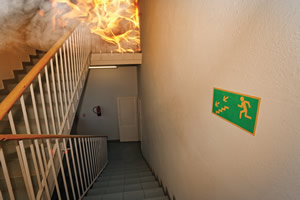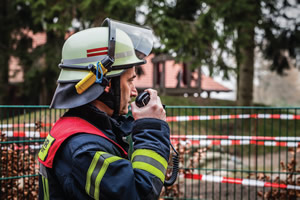Technology Enhances Fire Security

PHOTO © AMBROZINIO
Is anything more devastating than fire? Campus leaders everywhere understand the dangers that fire can pose to people and facilities, and they have taken a variety of preventive measures. But as technology advances, new capabilities offer the potential for even greater levels of security.
David Hall, emergency preparedness manager at Missouri State University, foresees tremendous capabilities being integrated into fire detection and alarm systems. He says these systems can enhance any institution’s capabilities for relaying appropriate and timely information to every person on campus.
“While mass notification systems can get a message out through text and email, fire alarm systems can ensure that mass notifications are received by everyone within a building, not just those associated with the campus,” he says. “In addition, fire alarm systems can allow for messages specific to the particular building to be provided.”
Hall says such warnings can help with threats such as tornadoes. He notes that while on most campuses a text or email alert and storm sirens will be activated, professors generally do not check their phones during class and do not allow students to do that either.
“Storm sirens are meant to be heard outdoors, so frequently they will not be heard in a classroom,” he says. “Having a distinct tone and message via a fire alarm system can allow prompt notification of non-fire emergencies.”
Notification on the Go
At the same time, systems that integrate with mobile devices do have much to offer, according to Kelley Stalder, engineer in the State Fire Marshal’s Office, Texas Department of Insurance.
“We think there is a lot of potential for systems that integrate with smartphones,” he says. “Every student seems to have one and while they might lose other things, they seem to keep track of their phone.” He says that privacy and misplaced phone issues can be addressed; smartphone integration can help college officials determine who is in an area, track their successful evacuation and control access based on the location of the phone.
“Today’s notification systems that are tied to fire detection, alarm and sprinkler systems are more advanced than ever,” says Jana Rankin, CEO of VuTeur, an Austin, TX-based security tech company. She points to the emergence of real-time location system (RTLS) services as an especially promising trend, since the systems are built in to devices such as smartphones and tablets and can be used for two-way communication in the event of an emergency.
“Using RTLS can also open up a wealth of possibilities for streamlining response and training for individuals within a college or university setting where mobile device usage is prevalent,” she says. Rankin notes that the system works by engaging the existing WiFi networks already in existence, thereby communicating directly with any device that’s connected to the facility’s network.
Whatever technologies are employed, special attention is merited for residential facilities, according to Billy Findley, vice president of service management at Koorsen Fire and Security. “With a large number of students living and sleeping in a single building, early warning that a fire is happening is critical,” he says. “It takes time to wake and evacuate that many people, even in a well-designed structure, so a loud and centralized alarm system is crucial.” This gives students a way to quickly signal everyone if they see a fire, and it also lets campus security personnel and the local fire department know so they can respond. “Smoke detectors are also part of the required fire code, and their beeping alarm can save lives, especially in the middle of the night when everyone is sleeping.”
Going beyond such basics, Findley affirms that integration with access control and other systems should be a goal. He says that while limiting access to the buildings on campus to students and approved personnel is a key part of maintaining security, it’s also important that authorities have all the access they need.
“If your fire alarm system is integrated with access control, you’re able to set and trigger events so that if a fire is detected, certain doors are closed and others are unlocked,” he says. “This will ensure that students have a quick way out, and first responders have a quick way in.”
Looking Forward
Hall advocates a high degree of integration with other systems. He says that while some in the fire service want to keep fire protection systems limited to fires, when looking at safety holistically the integration of fire alarm capabilities into other safety systems will be essential.

PHOTO © POSSOHH
LET’S WORK TOGETHER. During an emergency, phone and Internet traffic may knock phone systems and websites offline. Develop a strategy to keep the lines of communication online. Most campus safety departments have well-established protocols for alerting first responders, whether the police, fire or EMS. Ideally, a campus should have direct radio communication with local police or the 911 center. Develop relationships with your local first responders, and make sure they understand the unique features of your campus… including what mass notification and emergency communication systems you have in place.
“For many years, the fire service has tied their station alerting systems to other functions such as automatically opening the apparatus bay doors, turning on lights and turning off stoves,” he says. “This same technology can conceivably be applied to many functions on a college campus.”
Hall also advises developing relationships with local fire departments, particularly the fire marshal and fire prevention staff.
“Ensure they understand the unique challenges faced by your campus as well as making sure you understand their needs and concerns,” he says. “Architects and engineers usually have a thorough understanding of the building codes, but they may lack the understanding of the ‘why’s’ behind the fire code and do not understand why one fire department might apply the fire code differently than the next.” Hall notes that every fire department is different out of necessity, but notes that local fire code officials understand how the code affects their operations.
“By working as partners, you can help them at times when a fire emergency occurs,” he says. “Likewise, most fire departments are more than willing to help the campus deal with the unique challenges they face.”
Rankin agrees. She says it’s critical for campus leaders to go further than simply implementing new technology. A key is the willingness to engage with stakeholders across the board, including students, faculty, staff, campus security officials and outside agencies such as fire and police departments, as well as to provide proper training.
“The security systems in use on a campus or university are only as strong as the people who use them, and proper training is crucial,” Rankin says.
Hall adds that emergency preparedness is the prudent risk management strategy, and the best starting point is at the design stage.
“Designing buildings and campus features with safety as an integral part of the design process is the most cost-effective means to a safer campus,” he says. “The more our systems are designed to meet all of the risks we face, the more likely we are to mitigate or respond to an emergency.”
THE OFF-CAMPUS ANGLE
Kelley Stalder, engineer in the State Fire Marshal’s Office, Texas Department of Insurance, reports that more than 90 percent of fire fatalities occur in off-campus housing, with the greatest percentage due to smoking and intentional acts the second-most common causes. Whether they choose to live on or off campus, educating students on fire safety is vital.
“Spend some time educating your students on making good decisions,” he says. “All the equipment in the world won’t help if it’s not there.”
This article originally appeared in the issue of .